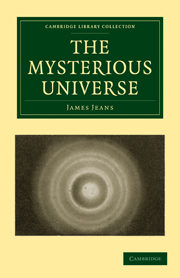IV - Relativity and the Ether
Published online by Cambridge University Press: 07 September 2010
Summary
We have seen how modern physics reduces the universe to systems of waves. If we find it hard to imagine waves unless they travel through something concrete, let us say waves in an ether or ethers. I believe it was the late Lord Salisbury who defined the ether as the nominative of the verb “to undulate.” If this definition will serve for the moment, we can have our ether without committing ourselves very far as to its nature. And this makes it possible to sum up the tendency of modern physics very concisely: modern physics is pushing the whole universe into one or more ethers. It will be well, then, to scrutinise the physical properties of these ethers with some care, since in them the true nature of the universe must be hidden.
It may be well to state our conclusion in advance. It is, in brief, that the ethers and their undulations, the waves which form the universe, are in all probability fictitious. This is not to say that they have no existence at all: they exist in our minds, or we should not be discussing them; and something must exist outside our minds to put this or any other concept into our minds. To this something we may temporarily assign the name “reality,” and it is this reality which it is the object of science to study.
- Type
- Chapter
- Information
- The Mysterious Universe , pp. 70 - 100Publisher: Cambridge University PressPrint publication year: 2009First published in: 1930

